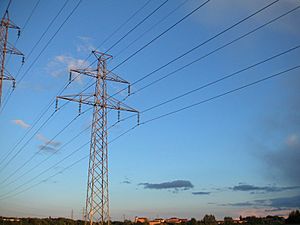Power transmission facts for kids
Power transmission is all about moving energy from where it's made to where it's needed. Think of it like a delivery service for energy! This energy helps us do work, like turning on lights or running machines.
Power itself is how fast energy is used or moved. We measure power in units called watts. For example, a 100-watt light bulb uses 100 watts of power. Moving power efficiently has always been super important as technology has grown.
Moving Electricity: Electric Power Transmission
When most people talk about power transmission today, they are usually talking about moving electricity. This happens through a huge network called a power grid.
Electricity is generated at power plants, often far from cities. It then travels through thick wires on tall towers, called transmission lines, or sometimes through underground cables. These lines carry electricity to substations, which then send it to homes and businesses. This system makes sure we have power for everything we do.
Moving Power with Machines: Mechanical Power Transmission
Before electricity became common, people used mechanical power transmission. This was very popular during the Industrial Revolution, which started in the late 1700s.
In old factories, a large engine would power a main spinning rod called a driveshaft. Smaller belts would then connect from this driveshaft to individual machines on the factory floor. This allowed one central engine to power many different tools.
Mechanical power can still be moved directly using solid parts, like the driveshaft in a car. Gears are often used to change how much torque (twisting force) or speed is sent to different parts of a machine. This is a bit like how an electrical transformer changes voltage for electricity.
Moving Power with Fuels: Chemical and Nuclear Energy
Energy can also be moved by physically transporting fuels. These fuels hold energy inside them, which can be released later.
For example, we transport natural gas through pipelines or as liquefied natural gas (LNG) on ships. We also move coal and petroleum (oil) around the world. These fuels are then burned in power plants or engines to create energy.
Other types of fuels include hydrogen gas, methanol, and ethanol. Even radioactive isotopes can be used as fuel in special power plants, like nuclear power plants. Moving these fuels allows us to use their stored energy wherever it's needed.



